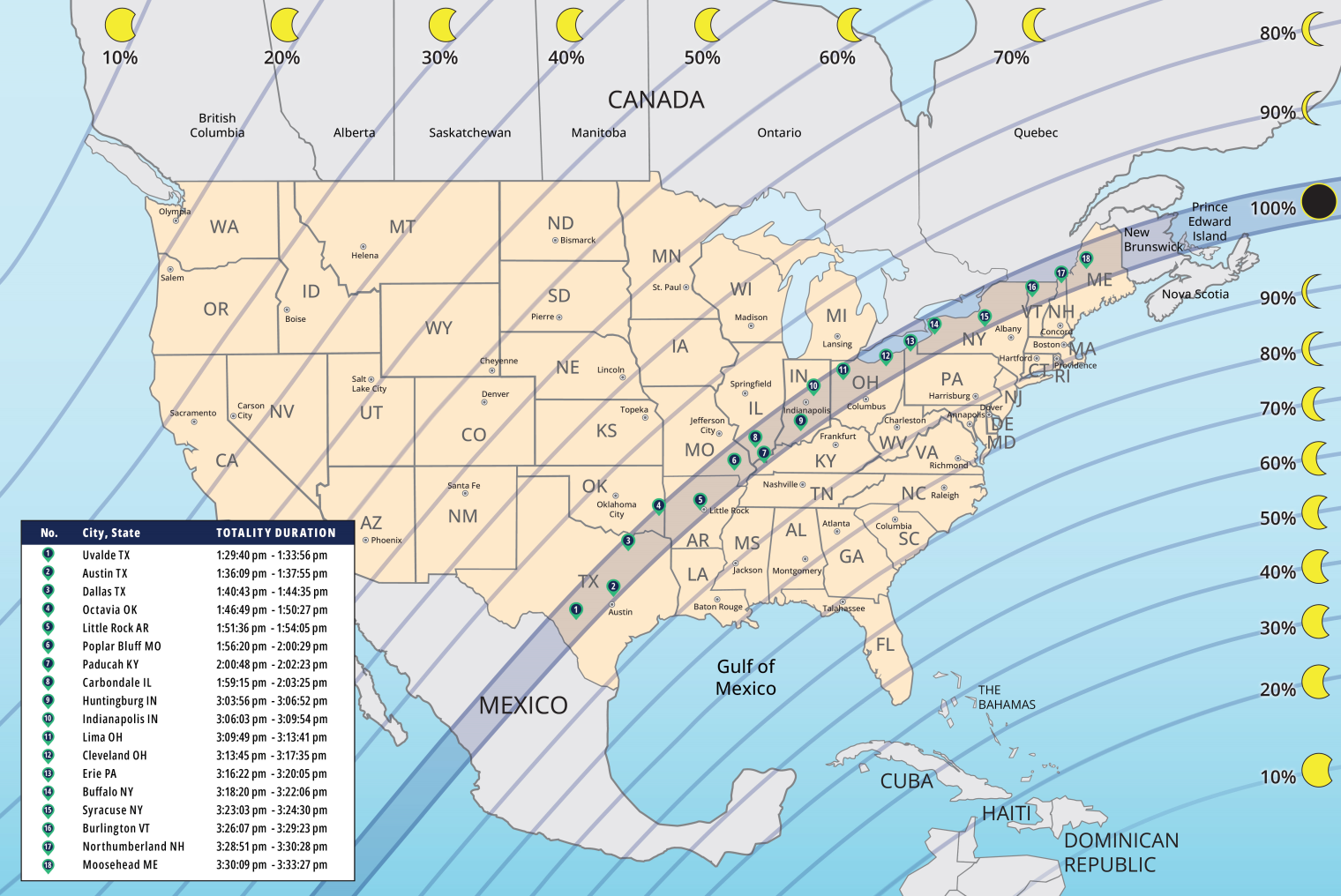| |
| FYI: Science Policy News from AIP |
| THIS WEEK |
|
|
|
|
|
|
| What’s Ahead |
 |
| The path of the April 8 eclipse. (NSF) |
Solar Eclipse Preparations in Full Swing
Science organizations plan to leverage the total solar eclipse on April 8 for a range of experiments and outreach activities. The eclipse’s path of totality will stretch across North America from Sinaloa, Mexico, to New Brunswick, Canada, hitting more than a dozen U.S. states along the way. To name a few of the planned experiments, NASA will launch three sounding rockets into the Moon’s shadow to study how the Sun’s disappearance disturbs Earth’s ionosphere and will use two aircraft to study the sun’s corona. NASA has also organized 53 student engineering teams into a Nationwide Eclipse Ballooning Project that will carry out hourly weather balloon launches for 30 hours during the eclipse. A jet from the National Center for Atmospheric Research will chase the eclipse as it moves across the U.S., observing infrared light emitted by the Sun’s corona. NCAR has launched a website with details on cross-disciplinary experiments and citizen science projects relating to the eclipse.
Among the outreach events, the National Science Foundation and partner agencies will host viewing events in Dallas, Texas, and Washington, D.C., and an educational livestream aimed at grade-school students. The American Astronomical Society has compiled resources for viewing the eclipse and has been raising awareness about eclipse safety, such as with warnings about the dangers of counterfeit eclipse glasses. (AAS is an AIP Member Society.)
Fights Over House Leadership and Ukraine Aid to Resume in April
Congress faces a raft of challenges when it returns from a two-week recess on April 9. House Speaker Mike Johnson (R-LA) has been threatened with removal by far-right members of his party who are angered by his compromises with Democrats in the appropriations legislation enacted last month, though it is unclear when a removal vote might occur. Democrats have expressed openness to voting to keep Johnson in office, but only in exchange for his support on a Ukraine aid bill. Regardless of the outcome of the speaker fight, House Republicans continue to grapple with their tight and shrinking majority. Recent retirements and the expulsion of George Santos mean the party can only afford two defections on party-line votes. That margin will shrink to one on April 19 when Rep. Mike Gallagher (R-WI) resigns.
With this backdrop, congressional leaders are still struggling to negotiate a supplemental spending package focused on national security priorities, mainly related to the Ukraine-Russia and Israel-Hamas wars and security along the U.S.-Mexico border. Senate Democrats have advanced a supplemental package totaling around $110 billion. Although the package is mostly focused on expanding weapons procurement and humanitarian assistance, a portion addresses goals involving science agencies, such as shoring up supplies of radioisotopes that previously were acquired from Russia and assisting Ukraine with nuclear nonproliferation initiatives.
Physicists Gather in Sacramento for APS April Meeting
|
|
| In Case You Missed It |
 |
| Vice President Kamala Harris, pictured speaking with AI company executives in May 2023, announced the White House’s policy on uses of AI across government in a speech on March 28, 2024. (Lawrence Jackson / The White House) |
Government-wide Policy on AI Issued by White House Budget Office
Vice President Kamala Harris announced a major policy last week that will govern how federal agencies can use artificial intelligence, as directed by President Joe Biden’s November executive order on AI. The policy, issued by the White House Office of Management and Budget, establishes many security and safety requirements for federal applications of AI but also includes various exceptions. Notably, the policy does not apply to AI used to conduct basic or applied research unless the purpose of that research is to develop AI applications for use by the agency.
The policy defines a set of “minimum practices” that agencies are required to follow when using or creating rights-affecting or safety-impacting AI – that is, AI designed to inform decisions that affect the rights or safety of individuals. These practices include real-world testing, independent evaluation, public documentation, impact assessments, and other basic software risk-mitigation standards. Agencies are also required to “proactively” share AI-related code they develop, and the policy specifically recommends doing so via the National AI Research Resource.
Agencies have until December 1 to make any AI they are currently using compliant with the policy or halt their use. Agencies can request waivers to allow them to continue using non-compliant AI. Among the remaining provisions, agencies are required to annually update their inventories of AI use-cases and designate chief AI officers.
DOE Announces $6 Billion to Reduce Industrial Carbon Emissions
Last week, the Department of Energy announced it plans to allocate up to $6 billion for 33 projects to demonstrate commercial-scale technologies for reducing carbon emissions from the manufacturing sector. Together, the projects aim to reduce emissions by an amount equal to that produced annually from 3 million gasoline-powered cars. The projects span a range of manufactured goods, including chemicals, metals, glass, cement and concrete, food and beverages, and pulp and paper. Of the total funding, $489 million is from the Infrastructure Investment and Jobs Act and $5.47 billion is from the Inflation Reduction Act. Nearly 80% of these projects are located in disadvantaged communities and each project is required to implement a Community Benefits Plan that “ensures meaningful community and labor engagement.” In order to receive the awards, the projects had to justify how they would benefit the surrounding area, especially areas with a history of environmental injustice. Examples of required benefits include strengthening local economies, preventing industrial pollution, and offering well-paying jobs that “support worker organizing and collective bargaining.” DOE will hold a series of briefings in April on these projects.
Gates Foundation to End Support for Article Processing Charges
The Bill and Melinda Gates Foundation announced a new open access policy last week, stating that the non-profit will no longer pay article processing charges and will instead encourage authors to publish their work in preprint journals. The new policy will take effect January 1, 2025. The foundation, a long-time proponent of open access publishing, said that a “culture shift” is required to ensure “the prioritization of equity and access over prestige and personal interest.” While APCs make research content free for readers to access, the high fees often make this option available “only to the most well-funded researchers,” the foundation said in a one-pager on its new policy. “New, more equitable models have not gained traction because publishers are slow to change and have pushed back when revenue is threatened,” the foundation asserted. The foundation’s move was welcomed by cOAlition S, a group of science funders pushing for immediate open access to research publications.
CHIPS Program Suspends Plans for R&D Facility Funds
The Commerce Department has suspended plans to issue a funding opportunity for the construction, modernization, or expansion of semiconductor R&D facilities, the CHIPS Program Office announced via newsletter last week. The decision is a consequence of “overwhelming demand” for funding from the $39 billion facility incentive program created by the CHIPS and Science Act, the office said, as well as due to program changes enacted through the final appropriations legislation for fiscal year 2024. Though this particular R&D funding opportunity has been put on ice, the office emphasized that it still plans to spend $11 billion on semiconductor R&D through separate programs funded by the CHIPS and Science Act. Commerce Secretary Gina Raimondo stressed in a recent speech that dispersal of the CHIPS funds is a balancing act. “At the outset, we said that we expected to invest about $28 billion of the program’s $39 billion in incentives for leading-edge chip manufacturing. But leading-edge companies alone have requested more than $70 billion, meaning we’re having many tough conversations,” Raimondo said. The CHIPS Program Office will discuss its strategy for supporting semiconductor R&D in an April 9 webinar focused on the National Semiconductor Technology Center.
|
|
| Upcoming Events |
All events are Eastern Time, unless otherwise noted. Listings do not imply endorsement. Events beyond this week are listed on our website.
Monday, April 1
Tuesday, April 2
Wednesday, April 3
Thursday, April 4
Friday, April 5
Monday, April 8
Know of an upcoming science policy event either inside or outside the Beltway? Email us at fyi@aip.org.
|
|
| Opportunities |
|
Deadlines indicated in parentheses. Newly added opportunities are marked with a diamond.
Job Openings
Solicitations
Know of an opportunity for scientists to engage in science policy? Email us at fyi@aip.org.
|
|
| Around the Web |
|
News and views currently in circulation. Links do not imply endorsement.
White House
Congress
Science, Society, and the Economy
Education and Workforce
Research Management
Labs and Facilities
Computing and Communications
Space
Weather, Climate, and Environment
Energy
Defense
Biomedical
International Affairs
|
|
|
| |
| This message is sent to you because your email address is on our subscribers list. To manage your FYI preferences and subscriptions, please click here . Or you can unsubscribe from all emails from AIP. AIP, 1 Physics Ellipse, MD 20740-3841
301.209.3100 - newsletters@aipcomm.org As a 501(c)(3) non-profit, AIP is a federation that advances the success of our Member Societies and an institute that engages in research and analysis to empower positive change in the physical sciences. The mission of AIP (American Institute of Physics) is to advance, promote, and serve the physical sciences for the benefit of humanity. |
|
| © 2024. American Institute of Physics |
|
|